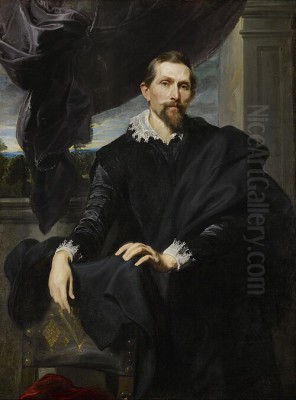
Frans Snyders stands as a towering figure in the vibrant landscape of Flemish Baroque art. Active primarily in Antwerp during the first half of the 17th century, he carved a unique and influential niche for himself, specializing in the dynamic depiction of animals and lavish still lifes. While his contemporaries like Peter Paul Rubens and Anthony van Dyck focused on history painting and portraiture, Snyders elevated the genres of animal painting and still life to unprecedented levels of monumentality, energy, and technical brilliance, leaving an indelible mark on the history of European art.
Early Life and Artistic Formation in Antwerp
Frans Snyders was born in Antwerp in October or November 1579. His father, Jan Snijders, was the keeper of a well-known inn frequented by artists, providing the young Frans with early exposure to the city's thriving artistic community. This environment likely nurtured his nascent interest in the visual arts. His formal training began in 1593 when he was apprenticed to Pieter Brueghel the Younger, a renowned painter known for continuing his father's peasant scenes and landscapes.
Following his time with Brueghel, Snyders is also documented as having studied with Hendrick van Balen I, a prominent painter of small cabinet figures and mythological scenes, who was also a teacher to the great Anthony van Dyck. This diverse training under masters specializing in different areas likely provided Snyders with a solid foundation, although his own path would diverge significantly from theirs, focusing intensely on the non-human world. Antwerp, at this time, was a major European artistic hub, fostering intense creativity and competition, pushing artists towards specialization and excellence.
Italian Journey and Maturation
Like many ambitious Northern European artists of his era, Snyders embarked on a journey to Italy to study firsthand the masterpieces of antiquity and the Italian Renaissance and Baroque. He traveled south in 1608, spending time primarily in Rome. There, he would have encountered the dramatic realism and chiaroscuro of Caravaggio and his followers, which may have subtly influenced his later handling of light and texture.
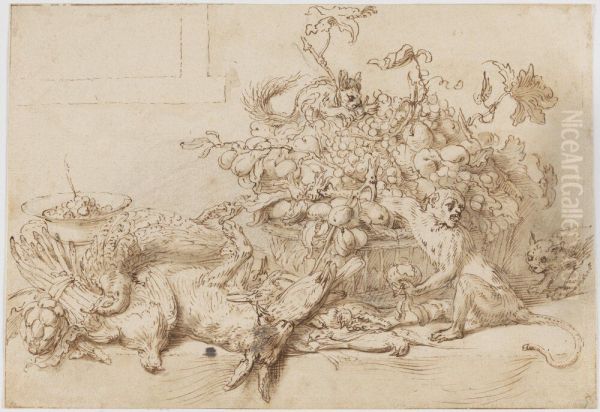
He also visited Milan, where reports suggest he stayed with Cardinal Federico Borromeo, a significant art patron. Jan Brueghel the Elder, known as "Velvet" Brueghel, a friend and future collaborator, recommended Snyders to the Cardinal. This Italian sojourn, though relatively brief (he returned to Antwerp in 1609), broadened his artistic horizons and solidified his technical skills before he established himself independently back home.
Establishing a Reputation: Master of the Guild
Upon his return to Antwerp in 1609, Frans Snyders quickly established himself as an independent master, joining the prestigious Antwerp Guild of Saint Luke. Membership in the guild was essential for any artist wishing to take on pupils or sell work legally within the city. His acceptance signifies his recognized skill and professional standing within the competitive Antwerp art scene.
In 1611, Snyders married Margaretha de Vos, the sister of two prominent Antwerp painters: Cornelis de Vos, primarily a portraitist, and Paul de Vos, who would become a notable animal painter himself, clearly influenced by his brother-in-law. This marriage further integrated Snyders into the city's artistic elite. His reputation grew steadily, built upon his exceptional ability to render the natural world with unparalleled vitality.
The Abundant Still Life: Markets and Pantries
Initially, Snyders focused primarily on still life painting, a genre gaining popularity in the Low Countries. However, he moved beyond the modest arrangements of earlier masters. Inspired perhaps by the late 16th-century market and kitchen scenes of Pieter Aertsen and Joachim Beuckelaer, Snyders infused his compositions with Baroque dynamism and an overwhelming sense of abundance. His canvases teem with life, showcasing overflowing baskets of fruit, heaps of vegetables, glistening fish, and displays of game and poultry.
Works like Still Life with Fruit, Vegetables, and a Monkey or the numerous depictions of Market Stalls and Pantries are characteristic. These are not merely inventories of goods but vibrant, almost theatrical displays. Snyders masterfully captured the varied textures of surfaces – the downy skin of peaches, the rough hide of a boar, the smooth scales of fish, the intricate patterns of woven baskets. His compositions are often complex, utilizing diagonal lines and dramatic lighting to create a sense of movement and depth, celebrating the bounty of nature and commerce.
Unleashing the Animal Kingdom: Hunts and Fables
While excelling at still life, Snyders truly distinguished himself through his revolutionary approach to animal painting. He moved beyond static depictions, capturing animals in moments of intense action, struggle, and interaction. His hunting scenes are particularly famous, portraying the ferocity of hounds attacking wild boars or stags with a raw energy and anatomical accuracy that was unprecedented.
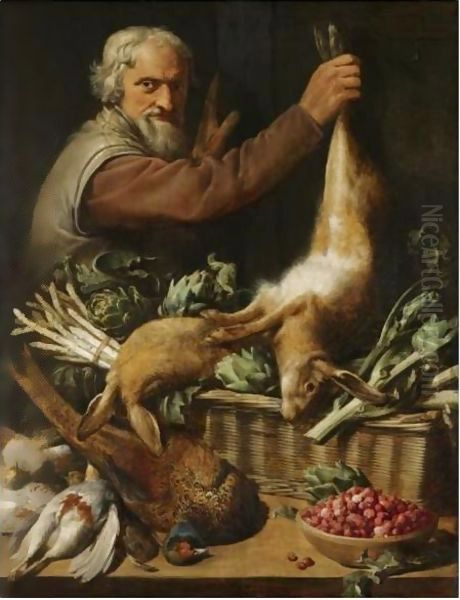
These large-scale canvases, such as Boar Hunt or Stag Hunt, are filled with snarling dogs, terrified prey, and the chaos of the chase. Snyders possessed an extraordinary ability to render the textures of fur and feathers, the tension of muscles, and the expressions of animal aggression or fear. He didn't just paint animals; he seemed to understand their nature, bringing their wild spirit onto the canvas.
Beyond the hunt, Snyders also painted scenes of animal concerts, like the delightful Concert of Birds, and illustrated fables, often depicting animals in dynamic, sometimes violent, confrontations. These works further showcased his versatility and deep observation of the animal world, solidifying his reputation as the foremost animal painter of his time.
A Fruitful Partnership: Collaboration with Peter Paul Rubens
One of the most significant aspects of Snyders's career was his close professional relationship and friendship with Peter Paul Rubens, the undisputed leader of the Antwerp school. Recognizing Snyders's unparalleled skill in depicting animals and still life elements, Rubens frequently enlisted him to contribute to his own large-scale compositions. This collaboration began around 1610 and continued for decades.
In many of Rubens's mythological scenes, biblical narratives, and allegorical paintings, the animals, fruit, garlands, and dead game were painted by Snyders. A prime example is Rubens's Prometheus Bound, where the ferocious eagle tearing at Prometheus's liver is attributed to Snyders. Similarly, in works like Diana and Her Nymphs Returning from the Hunt, Snyders likely painted the dead game and hounds. This division of labor allowed both artists to play to their strengths, resulting in masterpieces of collaborative energy.
The collaboration was reciprocal. Occasionally, Rubens or artists from his workshop, like Jacob Jordaens, would add figures to Snyders's large market scenes or pantry interiors, enhancing their narrative potential. The mutual respect between Snyders and Rubens was profound; Rubens was named as one of the executors of Snyders's will, a testament to their enduring bond.
Synergy with Antwerp Contemporaries
Snyders's influence and interactions extended beyond Rubens. He was a central figure in the Antwerp art world, collaborating or associating with many leading artists. His brother-in-law, Paul de Vos, became a successful animal painter heavily indebted to Snyders's style, sometimes leading to attribution difficulties between the two. His other brother-in-law, Cornelis de Vos, a respected portraitist, likely benefited from the family connection.

Snyders also collaborated with other major figures like Jacob Jordaens, who, like Rubens, sometimes added human figures to Snyders's compositions. Anthony van Dyck, another star of the Antwerp school, painted a striking portrait of Snyders and his wife Margaretha, indicating their social standing and connection within the artistic elite. Snyders's specialization complemented the work of these figure painters, making him an indispensable part of the collaborative workshop practices common in Antwerp. His work stands alongside that of Jan Brueghel the Elder, another master specialist (in flowers and landscapes), demonstrating the diverse yet interconnected nature of the Antwerp school.
Style and Technique: Baroque Vitality and Textural Mastery
Frans Snyders's style is characterized by its Baroque energy, rich color palette, and extraordinary attention to texture. His compositions are rarely static; they are typically dynamic, often built along strong diagonal axes, filled with movement and a sense of overflowing abundance or dramatic action. He employed vigorous, yet controlled, brushwork, adapting his technique to render the specific surface qualities of each object or creature.
His mastery of texture was perhaps his most remarkable technical achievement. One can almost feel the softness of fur, the prickliness of a thistle, the smoothness of silk, the coldness of marble, or the rough skin of a lemon in his paintings. He used light dramatically, often employing strong contrasts (chiaroscuro) to model forms, enhance textures, and create focal points within his complex arrangements. His colors are typically rich and saturated, contributing to the overall vibrancy and lifelike quality of his work. Even in his most crowded scenes, there is a clarity and specificity that speaks to his keen observational skills.
Workshop, Pupils, and Widespread Influence
Like most successful artists of his time, Snyders maintained a large and active workshop in Antwerp to help meet the demand for his paintings. He trained several pupils who went on to become significant artists in their own right, most notably Jan Fyt and Adriaen van Utrecht. Jan Fyt, in particular, became a leading master of animal and still life painting, continuing and developing Snyders's legacy into the next generation. Adriaen van Utrecht also specialized in lavish still lifes and market scenes, clearly showing his master's influence.
Snyders's impact extended far beyond his direct pupils. His innovative approach to still life and animal painting influenced artists throughout the Southern Netherlands and beyond. His works were highly sought after by collectors across Europe, including the Spanish royal family (Philip IV of Spain was a major patron) and various aristocratic patrons. His elevation of these genres inspired painters in the Dutch Republic, France, and Italy, contributing significantly to the development of still life and animal painting as respected independent genres in European art.
Patronage, Status, and Civic Role
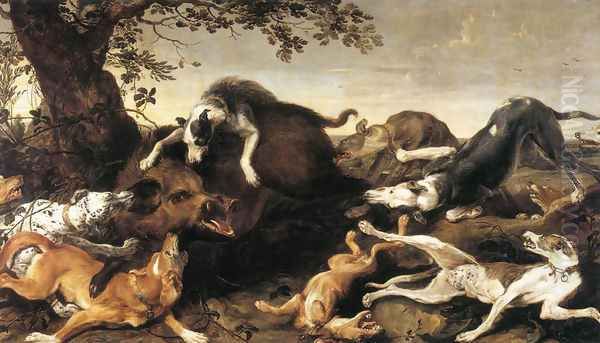
Frans Snyders achieved considerable success and social standing during his lifetime. His patrons included the Archdukes Albert and Isabella, governors of the Spanish Netherlands, who commissioned works from him. King Philip IV of Spain commissioned Snyders, alongside Rubens and other Flemish masters, to create a large series of hunting scenes for the Torre de la Parada hunting lodge near Madrid. This royal patronage cemented his international reputation.
Beyond royalty and aristocracy, Snyders also found patrons among the wealthy merchants and burghers of Antwerp. His financial success allowed him to live comfortably; the portrait by Van Dyck depicts him and his wife as affluent and dignified members of society. His standing within the artistic community was confirmed by his election as dean of the Guild of Saint Luke in 1628, a position of considerable honor and responsibility. He was a respected citizen and a leading light of Antwerp's golden age of painting.
Personal Life and Enduring Legacy
Details about Snyders's personal life beyond his marriage and professional activities are relatively scarce, suggesting a life focused primarily on his prolific artistic output. He and his wife, Margaretha de Vos, did not have any children. He lived and worked in Antwerp throughout his career after his return from Italy. He died in Antwerp on August 19, 1657, a wealthy and highly esteemed artist.
His legacy is substantial. Frans Snyders fundamentally changed the perception and execution of still life and animal painting. He imbued these genres with the dynamism, scale, and dramatic intensity previously reserved for history painting. His ability to capture the textures, movements, and vitality of the natural world remains astonishing. He demonstrated that subjects previously considered minor could be vehicles for profound artistic expression and technical virtuosity, paving the way for future generations of specialists in these fields. He remains a key figure for understanding the richness and diversity of Flemish Baroque art, standing alongside giants like Rubens and Van Dyck, but dominant in his chosen domain. His influence can be traced through artists like Jan Fyt, Paul de Vos, Adriaen van Utrecht, and even later French animal painters like Jean-Baptiste Oudry.
Snyders's Works in Collections Today
A significant number of Frans Snyders's paintings, as well as works produced by his active workshop, survive today, attesting to his prolific output and the high demand for his art during his lifetime and beyond. His works are housed in the collections of major museums across the globe.
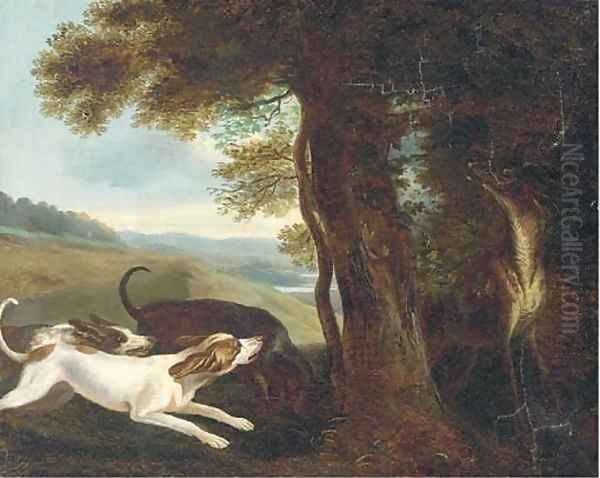
The Museo Nacional del Prado in Madrid holds one of the largest and most important collections, reflecting the extensive patronage he received from the Spanish monarchy. The Louvre Museum in Paris, the Hermitage Museum in Saint Petersburg, the National Gallery in London, the Rijksmuseum in Amsterdam, and the Royal Museums of Fine Arts of Belgium in Brussels all possess significant examples of his still lifes and animal scenes. Other notable collections can be found in the Alte Pinakothek in Munich, the Kunsthistorisches Museum in Vienna, and major museums throughout the United States, including the Metropolitan Museum of Art in New York. The widespread distribution of his work underscores his international fame and lasting importance.
Conclusion: An Unrivaled Master of Nature's Drama
Frans Snyders occupies a unique and vital place in the annals of art history. As a leading master of the Antwerp school during its most brilliant period, he specialized in genres often considered secondary but elevated them through his extraordinary talent and innovative vision. His lavish market and pantry scenes celebrate abundance with Baroque exuberance, while his depictions of animals—whether in the heat of the hunt, the chaos of combat, or quiet observation—possess an unparalleled energy and lifelikeness. His collaborations with Rubens highlight his specialized genius and central role in the Flemish art world. Through his mastery of texture, dynamic composition, and keen observation, Snyders not only dominated his chosen fields but also profoundly influenced the course of still life and animal painting across Europe, leaving behind a legacy of vibrant, powerful works that continue to captivate viewers today. He remains the quintessential painter of the Baroque menagerie and market stall.